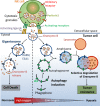Hypoxia: a key player in antitumor immune response. A Review in the Theme: Cellular Responses to Hypoxia
- PMID: 26310815
- PMCID: PMC4628936
- DOI: 10.1152/ajpcell.00207.2015
Hypoxia: a key player in antitumor immune response. A Review in the Theme: Cellular Responses to Hypoxia
Abstract
The tumor microenvironment is a complex system, playing an important role in tumor development and progression. Besides cellular stromal components, extracellular matrix fibers, cytokines, and other metabolic mediators are also involved. In this review we outline the potential role of hypoxia, a major feature of most solid tumors, within the tumor microenvironment and how it contributes to immune resistance and immune suppression/tolerance and can be detrimental to antitumor effector cell functions. We also outline how hypoxic stress influences immunosuppressive pathways involving macrophages, myeloid-derived suppressor cells, T regulatory cells, and immune checkpoints and how it may confer tumor resistance. Finally, we discuss how microenvironmental hypoxia poses both obstacles and opportunities for new therapeutic immune interventions.
Keywords: autophagy and antitumor immune response; cancer stem cells; circulating tumor cells; epithelial-mesenchymal transition; hypoxia; hypoxia-inducible factor; immune suppression; lymphoid cells; myeloid cells; programmed death-ligand 1; tumor microenvironment.
Copyright © 2015 the American Physiological Society.
Figures



Similar articles
-
Microenvironmental hypoxia orchestrating the cell stroma cross talk, tumor progression and antitumor response.Crit Rev Immunol. 2011;31(5):357-77. doi: 10.1615/critrevimmunol.v31.i5.10. Crit Rev Immunol. 2011. PMID: 22142164 Review.
-
Hypoxia-inducible factors in regulation of immune responses in tumour microenvironment.Immunology. 2014 Dec;143(4):512-9. doi: 10.1111/imm.12380. Immunology. 2014. PMID: 25196648 Free PMC article. Review.
-
The Antitumor Cytotoxic Response: If the Killer Cells Play the Music, the Microenvironmental Hypoxia Plays the Tune.Crit Rev Immunol. 2020;40(2):157-166. doi: 10.1615/CritRevImmunol.2020033492. Crit Rev Immunol. 2020. PMID: 32749093
-
CAR-T Cells Hit the Tumor Microenvironment: Strategies to Overcome Tumor Escape.Front Immunol. 2020 Jun 17;11:1109. doi: 10.3389/fimmu.2020.01109. eCollection 2020. Front Immunol. 2020. PMID: 32625204 Free PMC article. Review.
-
Hypoxic stress: obstacles and opportunities for innovative immunotherapy of cancer.Oncogene. 2017 Jan 26;36(4):439-445. doi: 10.1038/onc.2016.225. Epub 2016 Jun 27. Oncogene. 2017. PMID: 27345407 Free PMC article. Review.
Cited by
-
Lymphocyte Infiltration Determines the Hypoxia-Dependent Response to Definitive Chemoradiation in Head-and-Neck Cancer: Results from a Prospective Imaging Trial.J Nucl Med. 2021 Apr;62(4):471-478. doi: 10.2967/jnumed.120.248633. Epub 2020 Aug 28. J Nucl Med. 2021. PMID: 32859699 Free PMC article. Clinical Trial.
-
Inactivation of genes in oxidative respiration and iron acquisition pathways in pediatric clinical isolates of Small colony variant Enterobacteriaceae.Sci Rep. 2021 Apr 2;11(1):7457. doi: 10.1038/s41598-021-86764-4. Sci Rep. 2021. PMID: 33811225 Free PMC article.
-
Aberrations in Notch-Hedgehog signalling reveal cancer stem cells harbouring conserved oncogenic properties associated with hypoxia and immunoevasion.Br J Cancer. 2019 Oct;121(8):666-678. doi: 10.1038/s41416-019-0572-9. Epub 2019 Sep 16. Br J Cancer. 2019. PMID: 31523055 Free PMC article.
-
Correlation between imaging and tissue biomarkers of hypoxia in squamous cell cancer of the head and neck.World J Nucl Med. 2021 Aug 20;20(3):228-236. doi: 10.4103/wjnm.WJNM_91_20. eCollection 2021 Jul-Sep. World J Nucl Med. 2021. PMID: 34703390 Free PMC article.
-
Inhibition of HIF1α-Dependent Upregulation of Phospho-l-Plastin Resensitizes Multiple Myeloma Cells to Frontline Therapy.Int J Mol Sci. 2018 May 23;19(6):1551. doi: 10.3390/ijms19061551. Int J Mol Sci. 2018. PMID: 29882856 Free PMC article.
References
-
- Akalay I, Janji B, Hasmim M, Noman MZ, Andre F, De Cremoux P, Bertheau P, Badoual C, Vielh P, Larsen AK, Sabbah M, Tan TZ, Keira JH, Hung NT, Thiery JP, Mami-Chouaib F, Chouaib S. Epithelial-to-mesenchymal transition and autophagy induction in breast carcinoma promote escape from T-cell-mediated lysis. Cancer Res 73: 2418–2427, 2013. - PubMed
-
- Akalay I, Tan TZ, Kumar P, Janji B, Mami-Chouaib F, Charpy C, Vielh P, Larsen AK, Thiery JP, Sabbah M, Chouaib S. Targeting WNT1-inducible signaling pathway protein 2 alters human breast cancer cell susceptibility to specific lysis through regulation of KLF-4 and miR-7 expression. Oncogene 34: 2261–2271, 2015. - PubMed
-
- Allavena P, Piemonti L, Longoni D, Bernasconi S, Stoppacciaro A, Ruco L, Mantovani A. IL-10 prevents the differentiation of monocytes to dendritic cells but promotes their maturation to macrophages. Eur J Immunol 28: 359–369, 1998. - PubMed
Publication types
MeSH terms
Substances
LinkOut - more resources
Full Text Sources
Other Literature Sources
Molecular Biology Databases
Research Materials

